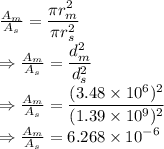
Physics, 11.12.2019 00:31 sandrafina2004
The moon has a diameter of 3.48 x 106 m and is a distance of 3.85 x 108 m from the earth. the sun has a diameter of 1.39 x 109 m and is 1.50 x 1011 m from the earth. determine (in radians) the angles subtended by (a) the moon and (b) the sun, as measured by a person standing on the earth. (c) determine the ratio of the apparent circular area of the moon to the apparent circular area of the sun. these calculations determine whether a total eclipse of the sun is really "total."

Answers: 3


Other questions on the subject: Physics

Physics, 21.06.2019 22:40, exoticbunnylover123
Consider two metallic rods mounted on insulated supports. one is neutral, the other positively charged. you bring the two rods close to each, but without contact, and briefly ground the the neutral rod by touching it with your hand. show answer correct answer what would be resulting charge (if any) on the initially neutral rod
Answers: 1

Physics, 22.06.2019 03:30, 1074885
The solar panels used by mark function because of the photoelectric effect. light shines on the cells causing electrons to be ejected from the metal, which produces an electric current. at night on mars, no light will fall on the solar cells and no electric current will be generated. according to your notes, what type of light is typically needed to cause the photoelectric effect? a)visible b)ultraviolet c)infrared
Answers: 1

Physics, 23.06.2019 00:00, jessicawolfking
What is the difference between mass density and weight density?
Answers: 1
You know the right answer?
The moon has a diameter of 3.48 x 106 m and is a distance of 3.85 x 108 m from the earth. the sun ha...
Questions in other subjects:

Mathematics, 27.10.2019 01:43






Mathematics, 27.10.2019 01:43










